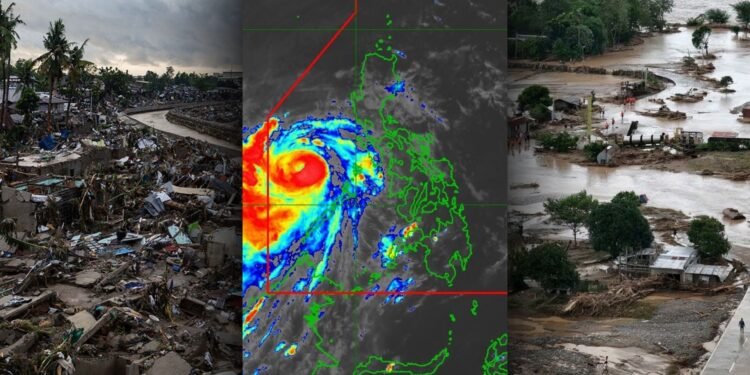The Philippines continues to face the brunt of relentless storms as Typhoon Tino and Super Typhoon Uwan leave widespread destruction across multiple regions, killing hundreds and displacing millions.
According to the National Disaster Risk Reduction and Management Council (NDRRMC), Typhoon Tino struck first, causing catastrophic damage across the Visayas and parts of Mindanao.
The agency reported around 230 deaths, with over 100 people still missing and more than 500 others injured. Most fatalities occurred in Cebu, followed by Negros Occidental and Negros Oriental. Additional casualties were reported in Antique, Iloilo, Guimaras, Leyte, and Bohol. The NDRRMC said most deaths were caused by drowning, electrocution, and falling trees.
Tino affected roughly 4.2 million people or 1.2 million families across eight regions. More than 380,000 individuals remain displaced, with over 240,000 still staying in evacuation centers. Infrastructure damage continues to hinder recovery, with 40 roads and seven bridges still impassable across Calabarzon, Mimaropa, and Western Visayas.
Power and water supply interruptions persist in at least 80 cities and municipalities, while communication lines in 60 areas—especially in Mimaropa, Central and Eastern Visayas, and Caraga—remain down as of Tuesday morning.
As communities struggled to recover from Tino, Super Typhoon Uwan followed, compounding the devastation. The NDRRMC confirmed 18 deaths across Cagayan Valley, Bicol, Western Visayas, and Eastern Visayas, with 13 others injured. Uwan affected about 2.4 million people or 650,000 families across Ilocos Region, Cagayan Valley, Cordillera Administrative Region, Central Luzon, Metro Manila, Calabarzon, Mimaropa, Bicol, Western and Eastern Visayas, Zamboanga Peninsula, Northern Mindanao, Caraga, and the Bangsamoro Autonomous Region in Muslim Mindanao (BARMM).
Now, with a potential third storm approaching, government agencies are rushing to reinforce weakened infrastructures and replenish relief supplies. PAGASA’s latest outlook warns that the developing system could track close to Luzon and Eastern Visayas—regions still saturated from Uwan’s torrential rains. Authorities have begun issuing early warnings as local governments prepare for preemptive evacuations and relief distribution in flood-prone areas.
Officials warn that the system may not be done. The Philippine Atmospheric, Geophysical and Astronomical Services Administration (DOST-PAGASA) now forecasts that Super Typhoon Uwan could possibly re-enter the Philippine Area of Responsibility on Wednesday, November 13, after passing Taiwan and continuing its recurving path. Emergency preparations are underway in coastal and exposed provinces.












